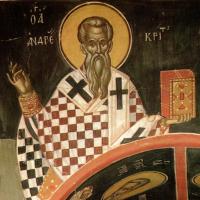Meeting of the Vladimir Icon of the Mother of God. The secret meaning of the icon "The Presentation of the Lord" Where is the icon
February 15 (February 2, old style) - Meeting of the Lord. Great Church holiday
WHAT IS THE MEANING OF THE LORD. HISTORY OF THE HOLIDAY
The Presentation of the Lord means the meeting of the elder Simeon with the Child in the Jerusalem temple at the rite of consecration of Jesus Christ to God.
It is known from history that Simeon was an unusual person, if only because his age at the time of the meeting with the Divine Infant was about three hundred years.
Its history began in Egypt, which, two centuries before the birth of Christ, was under the rule of the then mighty Greek kingdom.
The Egyptian king Ptolemy II (285-246 BC) had a huge library, which he decided to replenish with sacred Jewish books. 72 educated scholars from Jerusalem who knew both languages were hired to translate the texts. Among the invited people was the righteous Simeon.

When he was working on the book of Isaiah, at one point it seemed to Simeon that he had made a mistake in the 7th chapter. One of the verses read:
“Behold, the Virgin in the womb shall receive and give birth to a Son…”
According to the understanding of the righteous, a virgin could not become a mother, and he decided that it would be more correct to translate this word as “wife”. As soon as he tried to correct this “mistake”, an angel appeared to him and stopped his hand, saying:
“Have faith in what is written. You yourself will be convinced that these words will be fulfilled, for you will not taste death until you see Christ the Lord. Who will be born from the Pure Virgin.
Almost three hundred years have passed since that day, and Simeon, contrary to the laws of life, still lived on earth ... Until the very Nativity of Christ.
According to the law of Moses, on the fortieth day after birth, every first-born male in the family must be brought to the temple to perform the rite of passage. At the time of the birth of the Savior, this became a simple rite, while a sacrifice had to be made for the firstborn. The poor, which included the Holy Family, usually offered two doves: one for a burnt offering, and the other for a sin offering.
During this rite, Holy Mary, as if to the Lord Himself, gave Her Child to the vicar of God, the bishop, after which She redeemed the Divine Infant for 5 shekels. The priest began to read a cleansing prayer, ending this rite.
At this time, Elder Simeon was passing by the temple. Illuminated by the Holy Spirit, he understood who was in front of him, took the Divine Infant in his arms and glorified God for such joy. He finally received the greatest award of his life, which he could not even imagine.
The church also calls Simeon the God-bearer.

Mary and Joseph testified that the secret of their Son was known to Joseph, they were surprised by this. With a blessing, the venerable elder returned the Infant to the arms of the Mother and said:
“Behold, this lies for the fall and the rising of many in Israel, and for the subject of controversy. And to You Yourself a weapon will pierce the soul…” (Luke 2:34-35).
It turned out to be a prophecy not about joys, but, on the contrary, about misfortunes that were ahead.
The Holy Family could not return to Nazareth. Directly from Bethlehem, They were forced to flee from the persecution of King Herod, on whose orders 14,000 male infants under the age of two were executed. These were the first Christian martyrs.
SPIRITUAL MEANING OF THE FESTIVAL OF MEETING THE LORD
 Main spiritual meaning feast of the Presentation of the Lord - in the advent of the New World. The Old Testament, in the person of Simeon, gave way to the New Testament, Jesus Christ, along with the atonement of human sins against themselves and against God.
Main spiritual meaning feast of the Presentation of the Lord - in the advent of the New World. The Old Testament, in the person of Simeon, gave way to the New Testament, Jesus Christ, along with the atonement of human sins against themselves and against God.
It is also believed that Simeon was one of the important "witnesses" of the Divine origin of the Infant.
The Russian school of icon painting differs from the rest, and the icons of Andrei Rublev have become canonical, legitimized by the 17th-century hundred-headed cathedral as exemplary. And this is no coincidence. After all, Russian Orthodox icon of the golden XV century is full of tenderness, philanthropy, special softness and cordiality.
The icon "The Presentation of the Lord" is no exception. It reflects not only the plot and theological meaning of the holiday, but also its deep human meaning: once everyone has a meeting of God and man, Man and man, the Higher principle with the lower, there is a blessing to which a person responds with gratitude.
The icon of the Presentation of the Lord by the school of Andrei Rublev belongs to the type of icons of the holiday, in which the righteous Simeon receives the Infant from the hands of the Mother at the altar throne, referring the event to the future: the Savior is a redemptive sacrifice for people, the sacrificial principle of Jesus is emphasized here.
It has five characters. In the center is the Mother of God handing over the Child, and the God-bearer Simeon, receiving the Child from the hands of the Mother as the greatest shrine. Behind the Virgin stands the husband of Mary - Joseph the Betrothed, behind Simeon - the prophetess Anna. Thus, the icon is clearly divided into left and right sides: the left belongs to the new, the right to the old. Connects the left and right parts of the icon - Baby Jesus, located at the intersection of the left and right sides of the icon, uniting them in itself. The left side is directed up and to the right, the right side is directed down and to the left. Thus, in opposite movements, they meet at the point of transmission and acceptance of the Divine Infant.
“Now you release your servant, Lord, according to your word in peace ...” - the last words coming from the lips of Simeon, who accepts the Infant as deliverance from earthly burdens. The icon is entirely directed towards the light, to the Kingdom of Heaven, to the other world, where Simeon and Anna go.
Holiday date
The Orthodox Church celebrates the Presentation of the Lord on February 15 (February 2, old style)."Candlemas".
Annunciation Cathedral of the Moscow Kremlin.
And then Andrey will write "The Presentation". This holiday was already known in the 4th century. In Rome, in the church of Mary the Great, the oldest extant image, dating back to the 5th century, has survived to this day. Meeting in meaning is closely connected with Christmas. It was celebrated on the fortieth day after the Christmas celebrations. In Rus' in the first days of February, according to the old popular belief, after windy blizzard days the frost intensified. It was a deep winter. Preparations for spring field and other work did not begin. The days are still short. Quiet, contemplative time. The holiday itself is strict, in its hymns the mood of repentance grows. Rublyov's The Presentation turned out to be complex, deep in meaning, and at the same time so complete and integral that at first glance it might seem very simple. Yes, this is the mature fruit of high creativity, that seeming simplicity behind which stands so much thought, knowledge and labor. Someone will look at the icon, and the first impression is that the ritual is full of triumph and significance. Mary and Joseph bring the forty-day-old Jesus to the temple. Here, at the temple, the prophetess Anna lives. She predicts an unusual fate for a newborn. In the temple itself, they are met, hence the name of the event “meeting” - a meeting, the elder Simeon, to whom a promise has long been given that he will not taste death until he sees and takes into his arms the Savior of the world born on earth. And now he finds out, he clearly feels that this moment has come ...
On the icon, stepping steadily, a mother with a baby in her arms, Anna, followed by a betrothed, are moving towards Simeon at the same distance from each other.

Rublev depicted their tall, slender figures in such a way that they are seen as connected, flowing one into another.

Their measured movement, solemn, steady and irrevocable, as if pointing to its significance, is echoed by the easily curving wall, which depicts the entrance to the temple.

And towards the baby in a deep, humble bow, the old servant of the Old Testament temple stretches out reverently covered with clothes. Now he accepts in his arms ... his own death. His work on earth is over: "Now let your servant go, master, according to your word with the world ..." In place of the old, the old comes the new world, another covenant. And he, this new one - such is the universal and all-encompassing law of life - will have to take root in the world only through sacrifice. The young "young" is waiting for shame, reproach, and cross torment. In a restrained mood, in faces, as if covered with a haze of sadness, Rublev expressed this future, sacrificial, mortal. And the artist experienced this with special force when he painted the face of the Mother of God. For Andrei - and here he was not at odds with tradition - it was clear that Mary knew about the fate of her son, she also sees her own suffering, a "weapon" that "will pass her heart." This quivering maternal feeling is clearly visible, but given with a rare and noble measure of restraint. Everything that is destined to happen is necessary for people, for the whole world.
The impeccable color construction of the icon, strong, courageously and firmly correlated combinations are harmonized by the artist, softened by the precise and subtle rhythm of their location on the icon plane. The language that Rublev speaks here with the viewer is restrained, but very capacious. The artist is in no hurry to open up, to amaze with external movement, an explosion of feelings. It is necessary to get used to, peer slowly and thoughtfully into this icon, comprehend, discover, delve into its “images and meanings” shimmering with colors.
Valery Sergeev. Rublev. ZhZL series No. 618.
There is an important holiday - the Presentation of the Lord, and we simply cannot ignore this event. By tradition, the editors of the site have prepared up-to-date information about the date, traditions, signs and what is impossible on this day. Read about everything related to the Meeting of the Lord 2020 in our article below.
Grade
As for the traditions for the Meeting of the Lord, the church fathers used an already existing analogy - the feast of the meeting of Winter and Spring, celebrated in the same period as the Meeting of the Lord. The main rite of the Church of the Presentation of the Lord is the consecration of candles for the Presentation. The bottom line is that during the festive service in the church, candles are consecrated, and then they are distributed to the parishioners. Such candles were very much appreciated, they were always brought home and kept for a year.

The Day of the Presentation of the Lord: what not to do on the Presentation of the Lord
Orthodoxy The Presentation of the Lord, like others Religious holidays, has its limitations. So, what not to do on the Candlemas:
- you can’t miss the solemn service in the church, and if you can’t defend it entirely, you should go in and at least light a candle and pray;
- you can not swear;
- you can not clean the house, do laundry and, in general, carry out hard physical work;
- you can’t leave the temple without a candle - the consecrated Sretensky "loud" candle is carefully carried home and kept for a whole year;
- you should not go on a long journey - it can end unexpectedly and badly.
Icon of the Presentation of the Lord (Meeting in the Temple)
The icon "Meeting of the Lord" (or "Meeting in the Temple") has great importance for Christians, displaying the event of the meeting of the New Testament with the Old. The Feast of the Presentation is one of the most important twelfth Christian holidays.
The icon of the Meeting depicts the moment when the Mother of God brought the baby Christ to the temple, which has a deep meaning. The Meeting is a happy event, symbolizing the meeting of all mankind in the person of a righteous elder with God. The Candlemas icon itself looks elegant and festive, warm shades predominate in its writing, and the red color present symbolizes the solemnity of the current moment.
At the time of the birth of Jesus, the law of Moses was in effect, according to which parents were required to bring their first-born sons on the fortieth day from birth to be dedicated to God in the temple. It was in fulfillment of this law that Joseph and Mary brought the Christ child to the Temple of Jerusalem. In the temple of the Divine Infant, the 300-year-old elder Simeon, later named the God-Receiver for this, received.
The icon of the Meeting shows 5 figures. In the center is the Virgin Mary, passing Jesus, dressed in a short shirt that does not cover his legs, to Simeon. Her image is full of humility, she dutifully heeds the words of the elder's predictions, predicting her passion for her son. The righteous old man receives the divine baby, reverently bending over him. Baby Jesus blesses Simeon, releasing him after years of waiting for the fulfillment of the prophecy.
Behind of the Blessed Virgin the prophetess Anna and Joseph are depicted. The pious widow Anna recognized the Savior in the baby and praised God. Joseph, on the other hand, appears on the icon holding doves in his hands, since in those days it was necessary to bring a sacrifice to the temple for purification. And, although Mary, being the Ever-Virgin, does not need to be cleansed, the holy family exactly fulfills the Mosaic law.
The icon "Meeting of the Lord" is always present in the high iconostasis, you can see it in almost any temple and church. It is located in the third row among other icons of the festive row. Also, the icon "The Presentation of the Lord" may be present in the home iconostasis of righteous Christians.
The oldest image of the Candlemas that has survived to this day is the mosaic of the arch of the Roman basilica of Santa Maria Maggiore, written between 432 and 440 years. In Russia, the oldest fresco "Meeting of the Lord" is located in the Church of the Savior on Nereditsa, it was made in 1199. Ancient frescoes depicting the great event of the Candlemas can be seen in various Christian cathedrals and churches. The most ancient icon The Presentation of the Lord, dating from the 14th century, is kept in the Novgorod Museum.
Before the icon "The Presentation of the Lord" they pray, saying kontakion, magnification and troparion, those who read during the festive service. Prayer in front of her helps believers realize the greatness of the event of the Candlemas. Also, before the icon, you can say a prayer called "The Song of Simeon the God-Receiver." In addition, before the icon of the "Meeting" one can pray for the prisoners, the forgiveness of their sins and their speedy remission.



